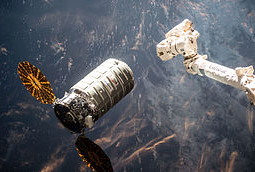
Status Reports: More information from ULA regarding the OA-6 Cygnus and the Atlas V MUOS-5 launch.

Cygnus CRS OA-6 approaching the ISS on 26 March 2016
ULA successfully delivered the OA-6 Cygnus spacecraft to the International Space Station (ISS) on March 22. During the first stage burn, the Atlas V system experienced an anomalous propellant mixture ratio resulting in an early booster shutdown and degradation of first stage performance. The Atlas V’s robust system design, flight software, vehicle margins and propellant reserves enabled the successful outcome for this mission.
The Centaur upper stage identified the first stage performance shortfall and compensated with an extended burn to deliver Cygnus to the precise orbit, well within the required accuracy.
Per standard processes when a flight data item such as this has been identified, the ULA engineering team, along with our engine supplier and several government customers, forms a robust review team. The review team assessed all flight and operational data to determine direct and root causes and implemented the appropriate corrective actions for future flights.
"Thanks to the robust vehicle system design of Atlas V, the OA-6 mission was delivered successfully to its intended orbit and Cygnus completed its’ mission to the ISS,” said Gary Wentz, ULA’s vice president of Human and Commercial Systems. “ULA applied a rigorous anomaly review process to identify and implement all necessary corrective actions to ensure we continue to reliably deliver critical capabilities for our customers with 100 percent mission success.”
An extensive review of all post-flight data observations determined that at approximately T+222 seconds, an unexpected shift in fuel pressure differential across the RD-180 Mixture Ratio Control Valve (MRCV) and a reduction in fuel flow to the combustion chamber caused an oxidizer-rich mixture of propellants and a reduction in first stage performance. The imbalanced propellant consumption rate resulted in depletion of the first stage oxidizer with significant fuel remaining at booster engine shutdown. The engine supplier has implemented a minor change to the MRCV assembly to ensure the anomaly does not occur on future flights.
Engine hot-fire testing, extensive component and assembly level testing and analyses have been performed to confirm the findings. Detailed inspections and minor hardware replacement on all engines will support the current launch manifest.
"We would like to thank our customers and supplier partners for their outstanding collaboration in the detailed review of this anomaly. We are honored to be entrusted with delivering America's most critical space assets to orbit and appreciate the outstanding team effort in delivering 100 percent mission success—one launch at a time,” said Laura Maginnis, ULA’s vice president of Custom Services. “'We remain on plan to launch all of our manifested 2016 missions within the year.”
The final and corrective action reviews, as well as flight clearance for the Atlas V MUOS-5 mission occurred on June 2. The Atlas V MUOS-5 launch is scheduled for June 24 from Space Launch Complex-41 at Cape Canaveral Air Force Station, Florida.
With more than a century of combined heritage, United Launch Alliance is the nation’s most experienced and reliable launch service provider. ULA has successfully delivered more than 100 satellites to orbit that provide critical capabilities for troops in the field, aid meteorologists in tracking severe weather, enable personal device-based GPS navigation and unlock the mysteries of our solar system.

